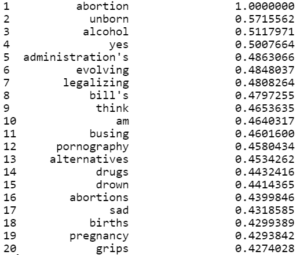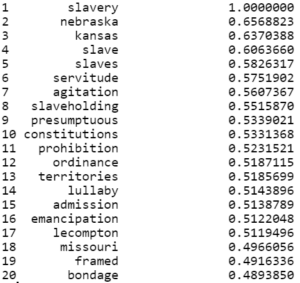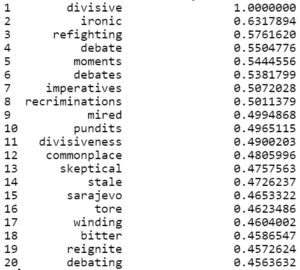By Emily Hontoria
Introduction
Nature of Divisiveness
Implicit in the above discussion is a definition of divisiveness in terms of perceived distribution of social opinion…A topic is maximally divisive when it splits society into two equal opinion groups.[1]
Defining Divisive Topics



Pivot to Divisive Ideas

It was interesting that it relates to things like moments, stale, and ironic. I looked a little deeper at ironic because it seemed like an interesting relation. Having looked at specific instances where ironic shows up, it does indeed show up in the neighborhood of divisiveness, and comes up close to topics like affirmative action and the deficit which I would call divisive topics. I would say that the idea of things parallel to the vector V(divisive)+V(ironic) may be interesting, which is what I looked at next. The question though becomes if this is how we pin down the neighborhood of divisiveness, what can we do with this?
Shortcomings and Ideas for Further Research
If I were to continue this research though, I would further explore the idea of how irony and divisive can be used to better answer the question of what topics are actually divisive. Although I didn’t get a concrete answer to my question, I feel like I got closer to it and found some interesting relationships along the way.
Bibliography
[2] – https://www.usatoday.com/border-wall/
[3] – Communication Research; 2018, Vol. 45(2) 165–187; © The Author(s) 2016; Reprints and permissions:
sagepub.com/journalsPermissions.nav; DOI: 10.1177/0093650216644025; journals.sagepub.com/home/crx; Divisive Topics as Social Threats; Joseph J. P. Simons and Melanie C. Green
[4] – A Semiotics of the Public/Private Distinction; differences: A Journal of Feminist Cultural Studies, Volume 13, Number 1, Spring 2002, pp. 77-95 (Article); Susan Gal
[5] – Sentiment Analysis of Social Issues; Mostafa Karamibekr and Ali A. Ghorbani; December 2012
[6] – https://millercenter.org/the-presidency/presidential-speeches; Miller Center Virginia
[7] – https://pythonprogramming.net/stop-words-nltk-tutorial/